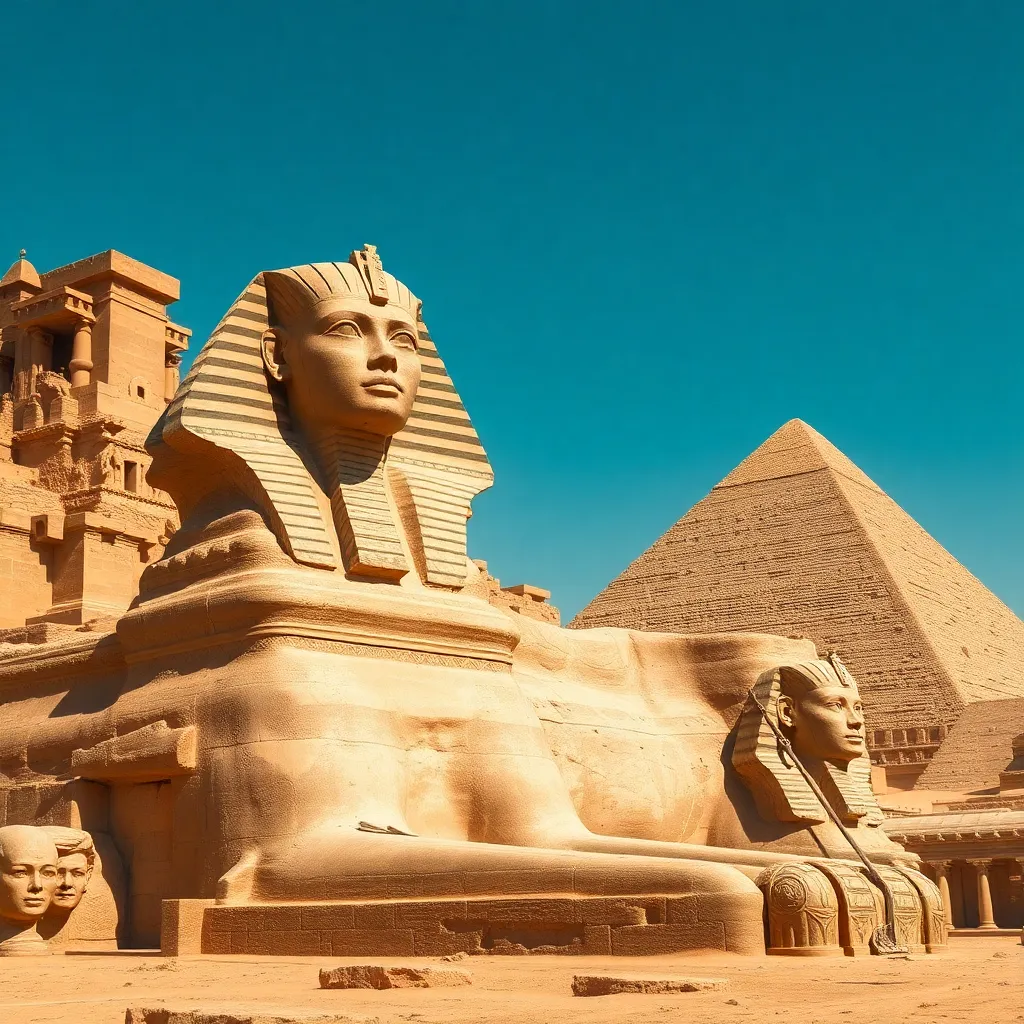The Sphinx and the Concept of Wisdom in Ancient Egypt
I. Introduction
The Sphinx, an iconic figure of Ancient Egypt, stands as a symbol of mystery and majesty. This mythical creature, with the body of a lion and the head of a human, has captivated the imaginations of people for centuries. As a cultural icon, the Sphinx represents not only the grandeur of Egyptian architecture but also the profound significance of wisdom in Ancient Egyptian society.
Wisdom was revered in Ancient Egypt, often associated with the divine and the pursuit of knowledge. This article aims to explore the multifaceted relationship between the Sphinx and the concept of wisdom, delving into historical contexts, representations of wisdom, and the Sphinx’s legacy in both ancient and modern times.
II. The Historical Context of the Sphinx
The Great Sphinx of Giza, one of the most recognizable monuments of the ancient world, was constructed during the reign of Pharaoh Khafre around 2500 BCE. This colossal statue measures approximately 73 meters long and 20 meters high, carved from limestone, and is believed to represent Khafre himself, symbolizing his strength and wisdom.
In relation to other monumental structures, the Sphinx is situated near the Pyramids of Giza, forming part of a larger complex that includes temples and smaller pyramids. This strategic location underscores its importance as a guardian of the necropolis.
Symbolically, the Sphinx embodies the duality of strength and wisdom. In Ancient Egyptian mythology, it is often associated with protection, serving as a guardian to sacred spaces and representing the connection between the earthly and the divine.
III. The Representation of Wisdom in Ancient Egypt
In Ancient Egyptian culture, wisdom was defined as the ability to discern right from wrong, to understand the natural and divine laws governing the universe, and to apply this understanding in daily life. It was considered a divine gift, bestowed by the gods.
Key texts such as the “Wisdom Literature,” including the “Maxims of Ptahhotep” and “The Teachings of Amenemope,” convey ancient wisdom through proverbs and teachings that emphasize moral conduct, social harmony, and the pursuit of knowledge.
The gods and goddesses played a crucial role in disseminating wisdom. For instance, Thoth, the god of wisdom and writing, was believed to impart knowledge to humanity, while Ma’at represented truth, justice, and cosmic order, emphasizing the importance of wisdom in maintaining balance in the universe.
IV. The Sphinx as a Symbol of Wisdom
The Sphinx’s features and design carry deep significance. Its lion’s body symbolizes strength and courage, while the human head represents intelligence and discernment. This duality reflects the Ancient Egyptian understanding of wisdom as a harmonious blend of might and intellect.
Moreover, the Sphinx’s association with the sun god Ra highlights its connection to knowledge and enlightenment. Ra, the embodiment of the sun and creation, was seen as the source of light and wisdom, further intertwining the Sphinx with the pursuit of wisdom.
As a guardian figure, the Sphinx also played a vital role in the concept of divine protection and guidance, standing sentinel over the pyramids and the passage to the afterlife, ensuring that the wise would find favor in the eyes of the gods.
V. The Sphinx in Ancient Egyptian Literature and Art
The Sphinx is depicted in various forms in Ancient Egyptian literature and inscriptions, often symbolizing wisdom and guardianship. These representations convey the reverence held for the Sphinx and its association with knowledge.
Artistic representations of the Sphinx also emphasize the theme of wisdom, showcasing the creature in temple reliefs and tomb paintings. These artworks often depict the Sphinx in the company of gods, reinforcing its status as a divine protector who embodies wisdom.
The influence of the Sphinx extends into later works of art and literature. Its imagery and symbolism can be found in Greco-Roman art, as well as in Renaissance works, illustrating the enduring legacy of the Sphinx as a symbol of wisdom and mystery throughout history.
VI. The Sphinx and the Quest for Knowledge
The Sphinx is famously associated with the riddle of the Sphinx in Greek mythology, where it posed a question to travelers and devoured those who could not answer. This narrative captures the essence of the relationship between wisdom and the pursuit of knowledge.
In Ancient Egypt, wisdom was not merely about acquiring knowledge but also about understanding its application in life. The pursuit of knowledge was revered, and individuals were encouraged to seek wisdom throughout their lives, reflecting the belief that true wisdom leads to enlightenment.
Lessons derived from the Sphinx’s myths resonate with contemporary society. They encourage individuals to seek knowledge, face challenges with courage, and appreciate the importance of wisdom in navigating the complexities of life.
VII. Modern Interpretations and Legacy of the Sphinx
The Sphinx continues to influence modern understandings of wisdom. Its image is often used to symbolize knowledge and mystery in literature and art, exemplifying the enduring fascination with Ancient Egyptian culture.
In popular culture, the Sphinx appears in various forms, from literature to films, often embodying themes of wisdom, riddles, and the quest for truth. Its symbolic meanings have evolved, yet the core association with wisdom remains intact.
The preservation and study of the Sphinx in contemporary archaeology have provided insights into Ancient Egyptian civilization. Ongoing research and excavations continue to unveil the mysteries surrounding the Sphinx, enriching our understanding of its historical and cultural significance.
VIII. Conclusion
In summary, the Sphinx stands as a profound symbol of wisdom in Ancient Egypt, intricately linked to the culture’s values, beliefs, and pursuits. Its majestic presence serves as a reminder of the importance of wisdom in guiding human behavior and understanding the universe.
The enduring legacy of Ancient Egyptian wisdom, as embodied by the Sphinx, continues to inspire and educate us today. As we reflect on the relevance of the Sphinx in our modern world, we recognize the timeless pursuit of knowledge and the value of wisdom in shaping our lives.




